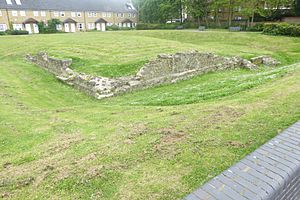King Edward III manor house facts for kids
The King Edward III’s Manor House is an old building near the Thames River in Rotherhithe, London. It's a very old house that was once owned by a king! Today, only parts of it remain, but they tell a long story about England's past.
Contents
Building a Royal Home
The first mention of a manor house in Rotherhithe was in 1127. At that time, King Henry I gave half of the land to the monks of Bermondsey Abbey.
The house you can see parts of today was built much later, around 1350. It was built by King Edward III. Back then, Rotherhithe was just a tiny village. The house was built on a small island and had several stone buildings. These buildings were set around a central courtyard.
Inside, there was a large hall with a fireplace. There were also private rooms for the king and his family, plus kitchens and other buildings. People aren't sure exactly what the house was used for. It probably wasn't a hunting lodge because there was no royal park nearby. Some people think it might have been used for falconry, which is hunting with trained birds. The north side of the house faced the river.
After King Edward III died, the manor house was given to the Cistercian monks of St Mary Graces by the Tower. Later, in 1399, it was given to Bermondsey Abbey.
What Happened Next?
In the 1500s, after a big change called the Dissolution of the Monasteries, the house was sold to private owners. This was when many church properties were taken over by the government.
By the 1600s, the old manor house became a pottery. Later, in the 1700s and 1800s, the area around it grew with many warehouses. The remains of the manor house were actually built into one of these warehouses. The front of the manor house was still standing in 1907.
The warehouse that contained the manor house was torn down in the 1970s. After that, in the 1980s, archaeologists dug up the site. They found the remaining parts of the manor house and made sure they were protected.
What You Can Still See
The walls of the manor house are made of large, smooth stone blocks at the bottom. Above that, they are made of rougher stones. The walls are quite thick, about 0.8 to 1.2 meters (2.6 to 3.9 feet) wide.
You can still see parts of the north, east, and west walls standing today. The rest of the building was reburied after the digs in the 1980s to protect it. The north wall is still 3.9 meters (12.8 feet) high, and the east wall is 3.8 meters (12.5 feet) high.
Protected History
The King Edward III’s Manor House is a very important historical site. In 1988, it was made a scheduled monument. This means it's a nationally important archaeological site that is protected by law. The protection covers the underground parts of the land, even up to the river's edge.
You can also find statues of Dr Alfred Salter and his wife Ada Salter on top of this protected land. They were important social reformers in the area.
A Special Area
The manor house is part of a special place called the Edward III’s Rotherhithe Conservation Area. This area also includes the nearby King's Stairs Gardens park. Being a conservation area means that the history and special character of the place are protected.


